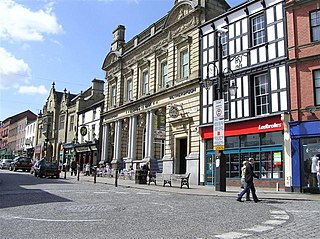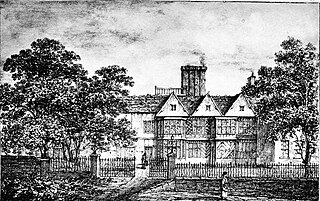
Samlesbury Hall is a historic house in Samlesbury, Lancashire, England, six miles (10 km) east of Preston. It was built in 1325 by Gilbert de Southworth, and was the primary home of the Southworth family until the early 17th century.

Smithfield, properly known as West Smithfield, is a district located in Central London, part of Farringdon Without, the most westerly ward of the City of London, England.

Bolton is a town in Greater Manchester in England. In the foothills of the West Pennine Moors, Bolton is between Manchester, Blackburn, Wigan, Bury and Salford. It is surrounded by several towns and villages that form the wider borough, of which Bolton is the administrative centre. The town is also within the historic county boundaries of Lancashire.

The Free Trade Hall on Peter Street, Manchester, England, was constructed in 1853–56 on St Peter's Fields, the site of the Peterloo Massacre. It is now a Radisson hotel.

Heaton Park is a public park in Manchester, England, covering an area of over 600 acres (242.8 ha). The park includes the grounds of a Grade I listed, neoclassical 18th century country house, Heaton Hall. The hall, remodelled by James Wyatt in 1772, is now only open to the public on an occasional basis as a museum and events venue. It is the biggest park in Greater Manchester, and also the largest municipal park in Europe.

Ancoats is an area of Manchester, England, next to the Northern Quarter, the northern part of Manchester city centre.

The Northern Quarter is an area of Manchester city centre, England, between Piccadilly station, Victoria station and Ancoats, centred on Oldham Street, just off Piccadilly Gardens. It was defined and named in the 1990s as part of the regeneration and gentrification of Manchester.

The Ancoats Hospital and Ardwick and Ancoats Dispensary was a large inner-city hospital located in Ancoats, to the north of the city centre of Manchester, England. It was built in 1875, replacing the Ardwick and Ancoats Dispensary that had existed since 1828. The building is now Grade II listed.

Wrexham city centre is the administrative, cultural and historic city centre of Wrexham, in North Wales and is the area enclosed by the inner ring road of the city. It is the largest shopping area in north and mid Wales, and the administrative centre of Wrexham County Borough. Many of its streets are pedestrianised.

Murrays' Mills is a complex of former cotton mills on land between Jersey Street and the Rochdale Canal in the district of Ancoats, Manchester, England. The mills were built for brothers Adam and George Murray.

The Daily Express Building, located on Great Ancoats Street, Manchester, England, is a Grade II* listed building which was designed by engineer Sir Owen Williams. It was built in 1939 to house one of three Daily Express offices; the other two similar buildings are located in London and Glasgow.

Brunswick Mill, Ancoats is a former cotton spinning mill on Bradford Road in Ancoats, Manchester, England. The mill was built around 1840, part of a group of mills built along the Ashton Canal, and at that time it was one of the country's largest mills. It was built round a quadrangle, a seven-storey block facing the canal. It was taken over by the Lancashire Cotton Corporation in the 1930s and passed to Courtaulds in 1964. Production finished in 1967.

Victoria Bridge is a stone arch bridge in Greater Manchester, England. Completed in 1839 and named after Queen Victoria, it crosses the River Irwell, connecting Salford to Manchester.

Great Ancoats Street is a street in the inner suburb of Ancoats, Manchester, England. It forms one of the stretches of the city's inner ring road.

Ancoats Hall in Ancoats, Manchester, England, was a post-medieval country house built in 1609 by Oswald Mosley, a member of the Mosley family who were Lords of the Manor of Manchester. The old timber-framed hall, built in the early 17th century, was described by John Aiken in his 1795 book Description of the country from 30 to 40 miles around Manchester. The old hall was demolished in the 1820s and replaced by a brick building in the early neo-Gothic style. The new hall, at the eastern end of Great Ancoats Street between Every Street and Palmerston Street, was demolished in the 1960s.

The following is a timeline of the history of the city of Manchester in north west England.

The Greek Orthodox Church of the Annunciation, Manchester is a Greek Orthodox church in Salford, Greater Manchester. Completed in 1861 in a classical architectural style, it is the oldest purpose-built Greek Orthodox church in England and since 1980, a grade II listed building for its “special architectural or historic interest”. As of 2017 the church provides liturgies on Sundays and acts as a hub for a community of an estimated 2,500 Greek diaspora, particularly Greek Cypriots, British Cypriots and Greek students in Manchester.
Manchester is a city in Northwest England. The M4 postcode area is to the northeast of the city centre, and includes part of the Northern Quarter, part of New Islington, and the area of Ancoats. This postcode area contains 67 listed buildings that are recorded in the National Heritage List for England. Of these, eight are listed at Grade II*, the middle of the three grades, and the others are at Grade II, the lowest grade.

Corn exchanges are distinct buildings which were originally created as a venue for corn merchants to meet and arrange pricing with farmers for the sale of wheat, barley, and other corn crops. The word "corn" in British English denotes all cereal grains, such as wheat and barley. With the repeal of the Corn Laws in 1846, a large number of corn exchanges were built in England, particularly in the corn-growing areas of Eastern England.

The Kilburn Building is a building on the Oxford Road in Manchester which is home to the Department of Computer Science at the University of Manchester. The building was designed by the Building Design Partnership and completed in 1972, with three storeys in a square shape, measuring 76 by 76 metres. The building was formerly known as the Computer Building changing its name in 2001 in honour of Tom Kilburn who died in the same year.


























